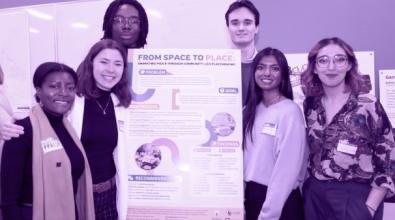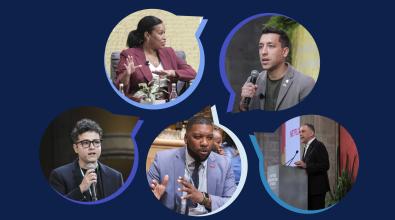Civic engagement: Taking work with residents to the next level

Something’s gone awry with the public meetings that have long anchored the ways local governments engage residents in decision making. Any leader who’s seen only a handful of people turn up for meetings—or worse, seen one of those forums turn into a shouting match—knows this first hand. So does anybody who’s attended a public hearing to speak their mind, only to be limited to 90 seconds at the end of an hours-long agenda.
A recent article in Vice summed it up this way: “The community feedback process is an inconvenient annoyance that brings out the worst in people. It is also at the heart of why U.S. cities can’t build new housing or transportation.”
It doesn’t have to be this way. And, in fact, civic engagement can work much better for everybody. That’s the premise of a new guide to civic engagement published this month by the Bloomberg Harvard City Leadership Initiative housed at the Bloomberg Center for Cities at Harvard University. Tailored specifically to city leaders, the guide unites research with practice to provide concrete tools for engaging residents in problem solving.
Bloomberg Cities spoke with three of the guide’s authors—Harvard’s Hollie Russon Gilman, Jorrit de Jong, and Archon Fung—for more of their insights about the state of civic engagement and how city leaders can take it to the next level.
Demand and distrust make now the perfect time for a reset.
Today’s challenges—from climate change to addressing discrimination to improving public health—are more complex than ever and can’t be solved without residents’ help. At the same time, misinformation and near-record distrust in government make residents less likely to engage with city hall.
That’s resulted in a surge of interest among local leaders in learning how to do this work better. In fact, mayors and senior city leaders participating in the Bloomberg Harvard City Leadership Initiative consistently rank improving civic engagement among their top priorities. “Public officials understand the status quo is not working,” Russon Gilman says. “To do public problem solving in the 21st century, it can’t be ‘us versus them.’ It has to be the city working with the residents, versus the problem.”
That said, public officials’ interest in better engagement hasn’t always been so strong, according to Fung, who says he’s witnessed a shift toward it over the past two decades. “People realize that trust in government is lower and the fact of being elected gets you less public trust and cachet than it used to,” he says. “You have to be engaging citizens all the time in order to generate the legitimacy to move forward.”
Getting your city where you want it starts with knowing where you are today.
Every municipality has its own history with civic engagement, with successes to build on and failures to learn from. Harvard’s new guide contains a self-assessment that city leaders can use as a diagnostic to understand what their city is good at and identify opportunities for improvement.
It’s important to “take a step back and ask: ‘Where is my city strong in engaging residents?’” de Jong explains. “‘Where has it historically been not so strong? And where are the opportunities for strengthening that capability in city hall?’”
Answering these questions will help cities articulate where they want to go, even if their goals seem out of reach at the moment. “It may not all be possible today,” Russon Gilman says. “It may take a two- or three- or four-year vision for how you want to do engagement.”
City leaders in Flint, Mich., took that approach in order to tackle the long-term problem of vacant and distressed properties. As part of its implementation of a 20-year master plan, the city launched an online portal where residents could find out who owns a property and report property conditions. The 120,000 messages residents sent through the portal in just two years not only helped the city get a grip on the problem, they also empowered residents to be part of the solutions, which were sometimes as simple as mowing a lawn.
There’s no one recipe for success—but there are key ingredients.
Civic engagement can utilize dozens of different tools, and successful efforts can take many forms. That’s why the guide doesn’t endorse any particular “best practices,” but rather, presents a framework for how to get on a good path.
The key is to be intentional about four things—why you’re engaging residents, what they’re being asked to contribute, who you’re asking to participate, and how you will engage them—and then design local initiatives with the answers to those questions in mind. “Your city is unique. The composition of your population is unique. Your history is unique,” de Jong says. “However, in order to engage residents in a meaningful way, you’ve got to be clear about those four things.”
Fung points to the legendary two-time mayor of Bogotá, Antanas Mockus, as an innovative leader who used civic engagement to change the culture of participation in his city. Most famously, he deployed 420 mimes to street corners to call out bad driving and encourage civility. That wouldn’t work in many cities today, but it struck a chord in 1990s Bogotá and cut traffic fatalities by more than half.
“More constructive, more deliberate forms of civic engagement are far better than the default ‘checkbox’ civic engagement—which is to announce a meeting, hold it and roll out your policy, and then hope for the best,” Fung says. “It’s important to be deliberate about why you’re trying to engage citizens and residents about what you are trying to do.”
This is an always-on process, because what works today won’t always work tomorrow.
In any number of city-led initiatives, resident engagement may be just one part of a time-bound project. It’s critical, however, for city leaders not to see it as something with a beginning and end, but rather, as an ongoing process that can be continuously improved upon.
Evaluation is critical. “Civic engagement is not a static practice,” de Jong says. “What works once doesn't work forever. Circumstances change, demographics change, and social, political, and economic conditions change. Big events can have a big effect on a city's trajectory. New technologies emerge and new ways of communication become available. For all those reasons, it's important for city leaders to take stock at certain intervals: What is working, what isn’t working, what can we tweak so that we're getting better results?”
Evaluation of its already successful Civic Bridge program, which creates volunteer opportunities for private-sector employees with specialized skills, led San Francisco to make inter-department changes to improve the program. Initially, Civic Bridge opportunities were driven by mayoral priorities, which didn’t ensure buy-in from city departments. But as the program evolved, city leaders realized how critical department support was to success, so they developed ways to work more directly with staff throughout the city to define problems and projects of focus.
Civic engagement has to be somebody’s job.
Part of getting better at civic engagement is institutionalizing its practice and creating internal structures within government to coordinate and elevate efforts across teams in city hall. That’s something cities such as Lancaster, Pa., and Jackson, Tenn., have done. In both cities, renewed efforts at engaging residents started with small community-led revitalization efforts through the Love Your Block program, and have since evolved into the creation of neighborhood services departments to lead civic engagement forward.
“It’s absolutely critical to have champions of participation on the government side, and ideally some institutionalization in an office of neighborhoods” or other entity, Fung says. “Many people in city government may see participation as a pain that slows things down and creates more demands on city government. Unless you have somebody on the city side who’s really championing deliberation, then it will just fall by the wayside.”


